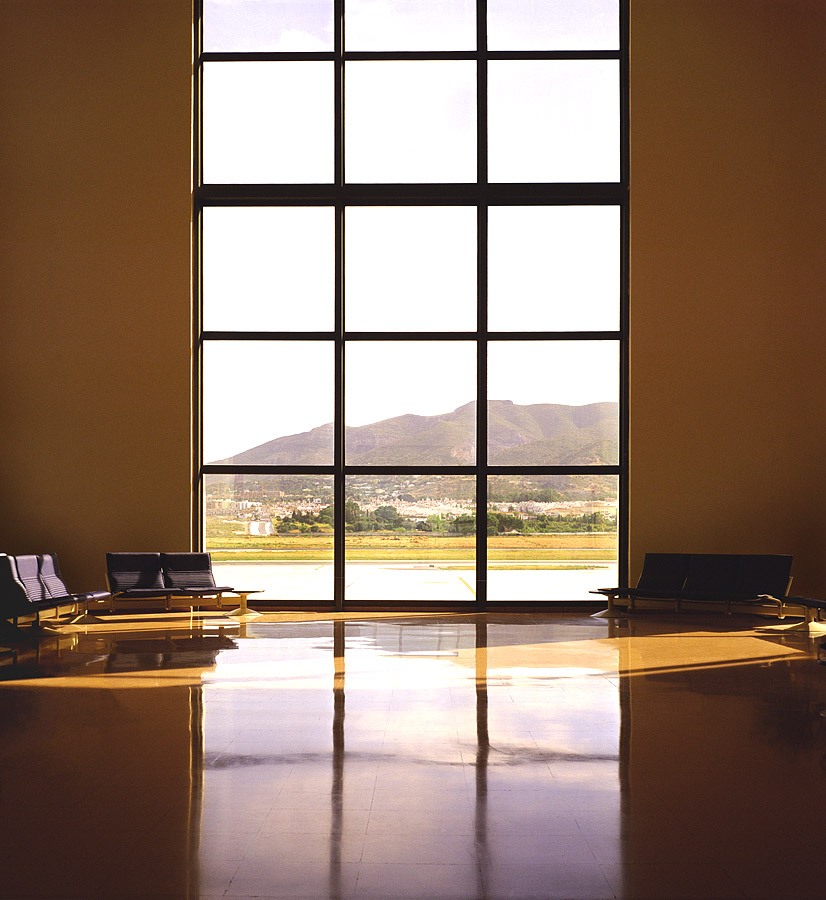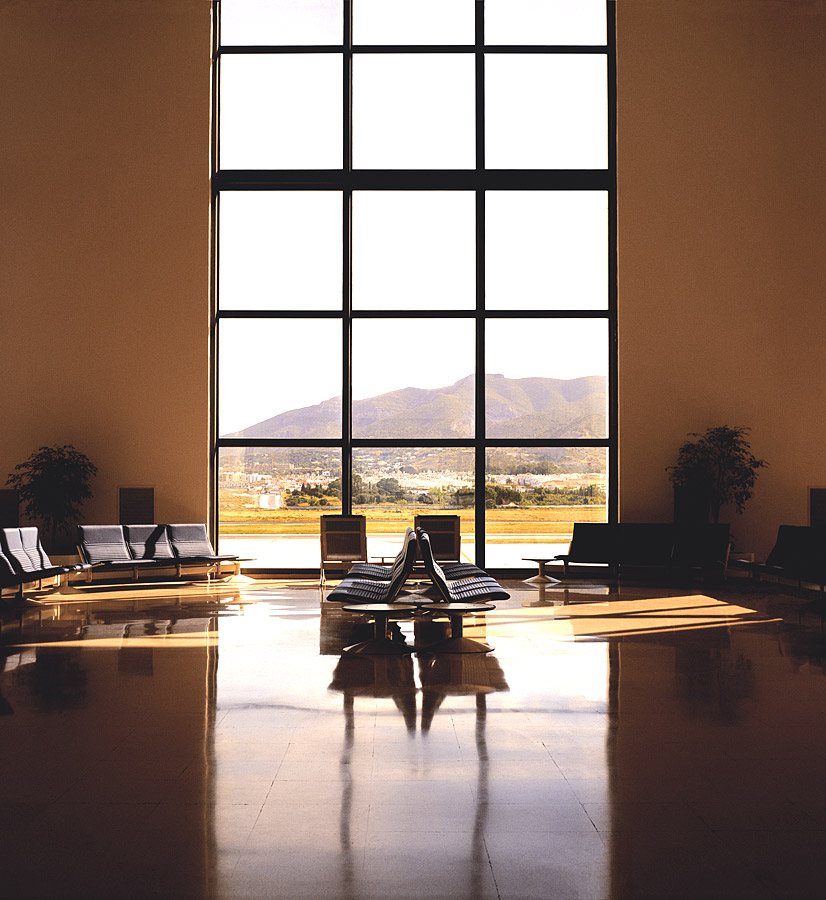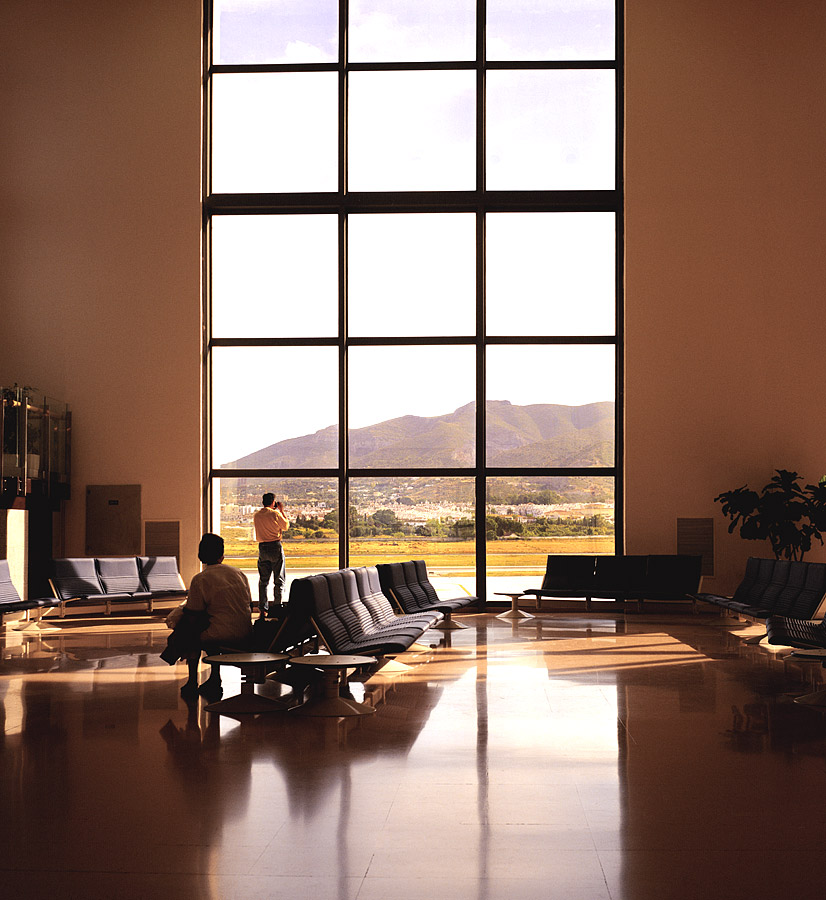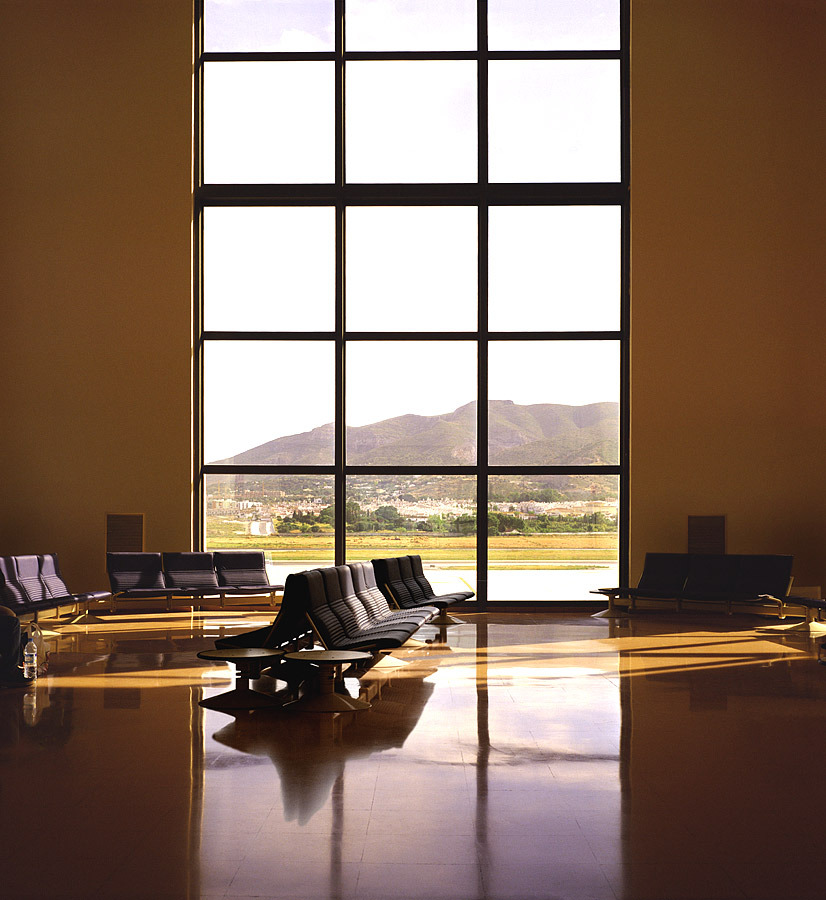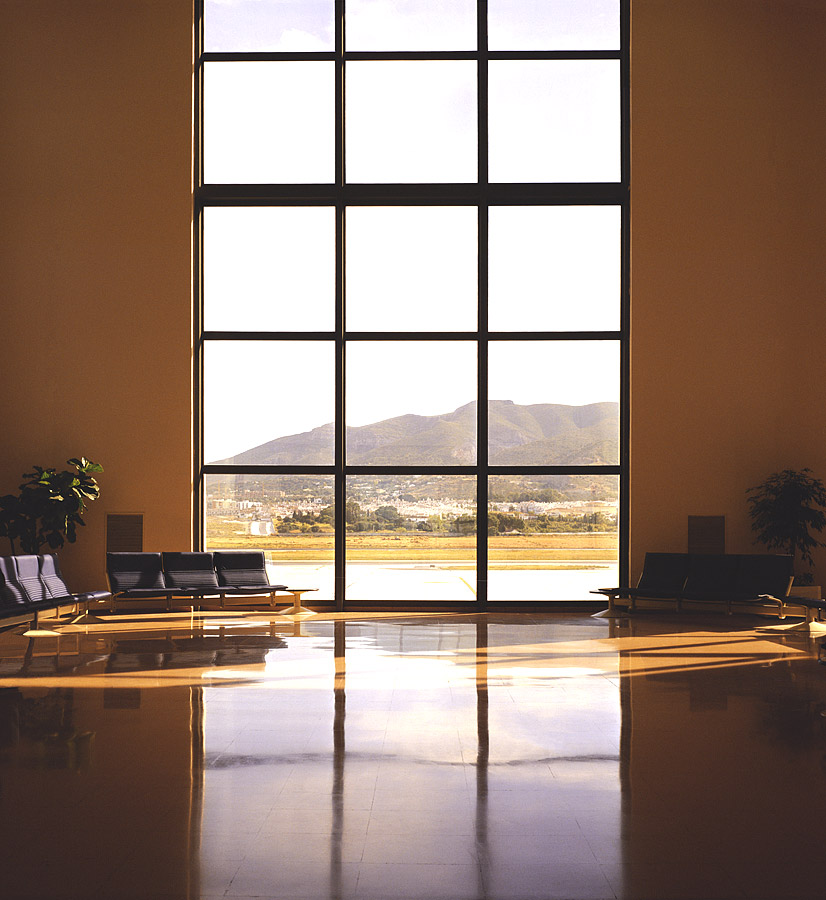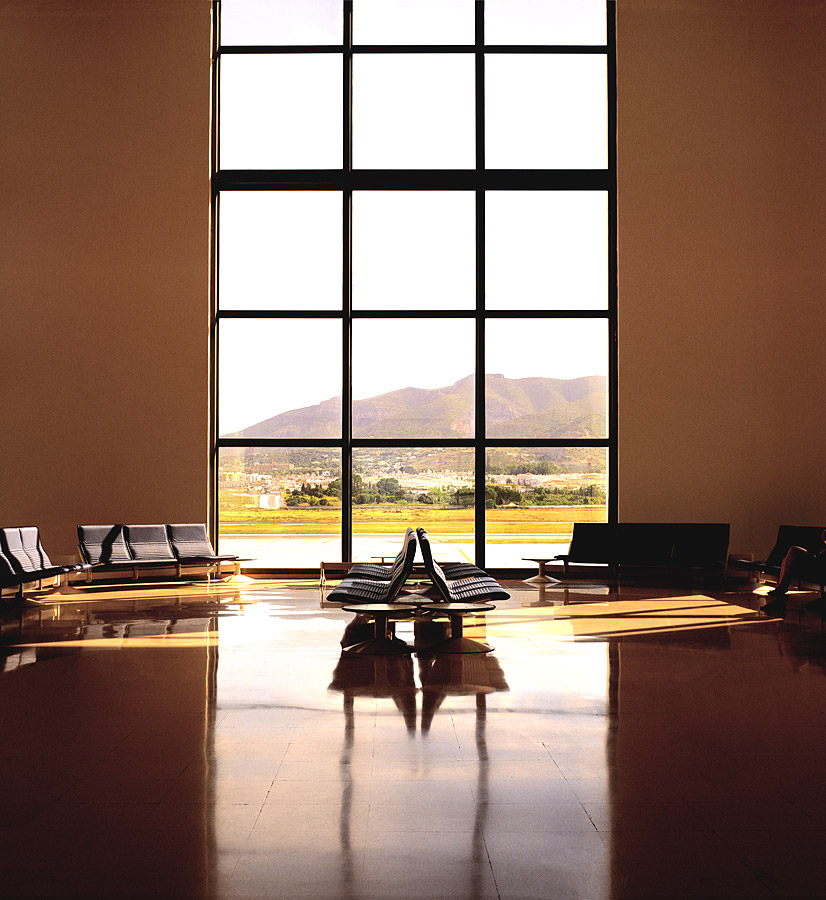Indoor
“Anyone who doesn’t want to think, will be kicked out” - this schoolmaster’s threat, from a famous artist’s postcard by Joseph Beuys, also applies when looking at Peters’s works. For we might find that the vacation idylls presented to us in the large-format photographs like, for example, Calypso (p. 119), are utterly fine, and hence we may enjoy them, but then we would not be doing justice to what the photographs demand of us and to their value as something more than wordless aesthetic affirmation.
It should be kept in mind that the photograph Calypso does not depict the beauty of truth but was created through a barely evident montage of various views that can never exist simultaneously in reality. The wonderful overview that gives us the feeling that we dominate optically the terrain beneath us, so to speak, is a visual illusion. Here Peters approaches the attitude of a Renaissance artist like Andreas Gursky, who communicates his quasi-divine power when we allow him to overwhelm us with the gigantic worlds he has created (fig. 2). At the same time, their artificiality and the violence that they do to reality compels us to resist the seduction of being wrapped up in something supposedly greater and to see through the mechanisms of this aesthetics of the overwhelming.
We may very well enjoy it, if we remain aware of the illusory aspect, based on pleasure, and arm ourselves with skepticism. Naturally this “intellectual movement” is not only about the images but about the reality that they show us - just like the reality of vacation in Peters’s works.
Peters’s series, in particular, call for this sceptical attitude from the viewer, which preserves a distance between the viewer and the world of the image to resist the latter’s seductive power. This is because it is only by comparing the individual images in the series that the mechanics of the illusion become clear, since this act requires us to step out of the world of the images. This alone makes it clear that in fact it is the exceedingly narrow format of the series Skyline (see p. 18 and pp. 36- 49) that represents the real theme of these photographs. Their upper zone becomes an abstract, almost monochrome plane that no longer stands for “sky” but develops its own aesthetic qualities that play with the image as a contained plane. To that end, the artist cleaned this surface, removing the clouds completely, or the stars as in the case of the Night Pieces. As in the works from the series Open Studies it becomes clear that Peters is not concerned with documentation but with the staging of the specific aesthetic of the image and of transforming reality into an image. It is also only on seeing the sequence that it becomes evident that the works in the series Indoor (see fig.3 and pp. 94 - 101) differ only in the arrangement of the furniture [Möbel] in the room, the mobilia (as opposed to the real estate [Immobilien]), and the shadows and reflections that it produces. For example, the landscape and the sky in the background are the same in every photograph in the series - Ralf Peters simply copied them in. This can be seen best by looking at the form of the window, with its quadratically arranged crossbars, through which the backgrounds can be seen through a regular grid and thus checked. Such visual grids have long been used not so much as a method of discovering the same as rather a way of producing the same, of copying. From the procession of clouds we can see time pass. Here, however, the various arrangements of furniture need no time - their rearrangement is not a process as in real life; rather the temporal form of the image is suddenness and static duration. In the image something that would otherwise be almost a miracle is entirely unproblematic, because in the image’s area of applicability - marked by the format - its own laws apply. As in a spread-out field, in which every point is an indispensable part of a whole, the artist creates a composition in every image that is in equilibrium along the plane. The window and its reflection on the floor, for example, form the verticals that complement the horizon of the furniture arrangement. It results in a crosslike shape that stabilizes the image, providing the firm structure of a whole as a counterweight to the variableness of the composition on the level of the elements of furniture. In the reality of the three-dimensional room, by contrast, this pictorial form can play hardly any role at all, since it pertains only to one viewpoint and cannot be perceived there with respect to the demarcations that make up the image. In life such artworks are the true refuges of fortunate experience. They do not feign paradises; rather, recognizing their artificiality is the precondition for our being able to raise ourselves to their level intellectually. The opening remark that something is off in Ralf Peter’s images is based on the confusion resulting from our bad habit of taking images for reality, and it releases the energy necessary to learn to see differently. In a cultural epoch like the current one, in which so much power is attributed to images without developing the instruments of understanding on the same level and in a general way, the techniques practiced here of thoughtful and reflective seeing can certainly be considered part of a program for cultural self-development.
This impression is confirmed by the series of images that Peters has made, which offer a view out of an imaginary window onto the world outside. This is especially the case if you compare it with the portraits of the twelve “different” women. For it immediately becomes clear that they are related. To put it another way: the one group of works complements the other. The way they interrelate broadens the field of what might potentially become visible. The comparison becomes still more revealing in view of the fact that
some of the photographs taken from windows, such as those in the series Seoul, have been digitally altered, while the three “original photographs” from the series Indoor (pp. 101–103) show “almost empty” images that according to Peters “were dreamt up on the computer.” What are we looking at? Is it a reflection of reality or a mere computer simulation?
Even this question can’t be answered easily. Seoul is made up of a group of three, almost square pictures (90 × 84 cm) with an identical format and structure (pp. 158, 159). Each has an internal frame running along the top and the bottom, which is cut away along the left- and right-hand sides. The cut edges are strengthened by two adjacent rising verticals in the interior part of the picture. The pictures show a kind of window within a window. In their upper half, a narrow horizontal line cuts across the entire surface of the picture. Behind it, a grille-like structure fans out. It is more clearly visible in the middle than in the lower part. Beyond this inner frame, the grille continues in a different color. In some places it is fully intact, in others only partly, and in others it is painted over in a translucent white, as if someone had whitewashed it. It is all pure illusion. No painter has put his hand to it. Even the delicate rendering of the internal frame and the rendered brackets at the edge of each picture, as well as the beams on the brackets in the central picture of the triptych, have been produced by an elaborate computer operation. Whether consciously or unconsciously, Peters is quoting here the shining “luster” of painting, which Ernst Gombrich believes originated with Apelles, the outstanding painter of Antiquity. Given this, is it really pure coincidence that no original painting of his has survived? For in Peters’s work it is only these lustrous outlines of forms rendered in light and shade that establish the character of the window-picture and at least suggest three-dimensionality.
Is this a reflection of reality or a computer simulation? It is equally neither and both. All that can be seen is what is to be seen, or more precisely, what may emerge on closer inspection, very much in the sense of Frank Stella’s “what you see is what you see.” Unlike Stella, though, Peters is not interested in producing a self-referential visual object, but rather in producing visibility itself. There is nothing more natural than this. Diane Arbus once noted in her diary that people don’t see things because they’re visible; rather the other way round, they are visible because people see them. In this short sentence, the great photographer summarized what western art has had its eye on, so to speak, since breaking free of the spell of religion: to make things visible. In the final analysis, the visible world is the product of images.
In the meantime, the visual mass media have been using polished and clichéd images to cover over again what art had mapped out in the realm of the visible. Critical art has reacted to this trashing of the visual by reflecting clearly on the conditions of visual representation. More specifically, its subject is now visibility itself, and no longer the representation of a particular subject. Instead of a subject that isn’t there at all but is merely a symbol referring to “reality,” what Peters’s “photographic” pictures show are the possibilities for producing visibility. Just as the eyes of the subjects of Different Persons scarcely allow the viewer to gaze into their souls, so the window in the triptych Seoul offers no more than a glimpse of the South Korean capital. Instead, what one catches sight of are potential images of people and things, whose relation to the world beyond images is extremely fragile and uncertain. At the most, they are able to preserve traces of reality.
As a result, Peters shifts the focus of his apparently perfect pictures from photography’s natural tendency to produce symbols to an illustration of the actual language of images. The opposition between analog and digital photography resolves itself independently of their respective technical wherewithal. The result is an apparent tautology: each of the artist’s pictures conveys first and foremost its own nature as an image; in other words, that it is an image. And it is this that forms the critical aspect of Peters’s work.
